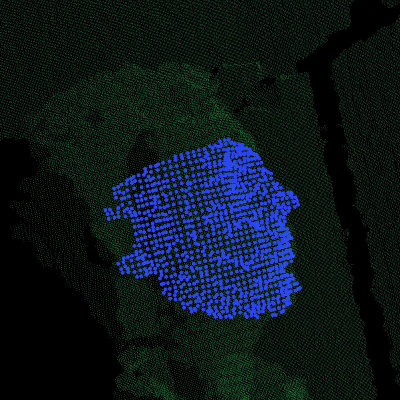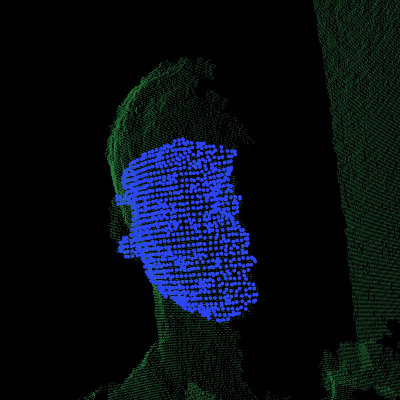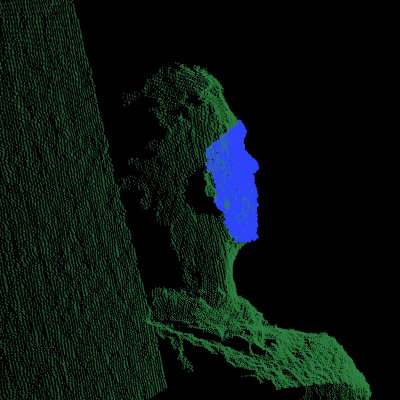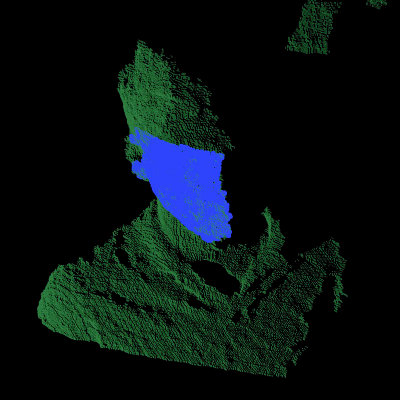Aligning object templates to a point cloud
This tutorial gives an example of how some of the tools covered in the other tutorials can be combined to solve a higher level problem — aligning a previously captured model of an object to some newly captured data. In this specific example, we’ll take a depth image that contains a person and try to fit some previously captured templates of their face; this will allow us to determine the position and orientation of the face in the scene.
We can use the code below to fit a template of a person’s face (the blue points) to a new point cloud (the green points).
The code
First, download the datasets from github.com/PointCloudLibrary/data/tree/master/tutorials/template_alignment/ and extract the files.
Next, copy and paste the following code into your editor and save it as template_alignment.cpp (or download the source file here).
1#include <limits>
2#include <fstream>
3#include <vector>
4#include <Eigen/Core>
5#include <pcl/memory.h>
6#include <pcl/pcl_macros.h>
7#include <pcl/point_types.h>
8#include <pcl/point_cloud.h>
9#include <pcl/io/pcd_io.h>
10#include <pcl/kdtree/kdtree_flann.h>
11#include <pcl/filters/passthrough.h>
12#include <pcl/filters/voxel_grid.h>
13#include <pcl/features/normal_3d.h>
14#include <pcl/features/fpfh.h>
15#include <pcl/registration/ia_ransac.h>
16
17class FeatureCloud
18{
19 public:
20 // A bit of shorthand
21 typedef pcl::PointCloud<pcl::PointXYZ> PointCloud;
22 typedef pcl::PointCloud<pcl::Normal> SurfaceNormals;
23 typedef pcl::PointCloud<pcl::FPFHSignature33> LocalFeatures;
24 typedef pcl::search::KdTree<pcl::PointXYZ> SearchMethod;
25
26 FeatureCloud () :
27 search_method_xyz_ (new SearchMethod),
28 normal_radius_ (0.02f),
29 feature_radius_ (0.02f)
30 {}
31
32 ~FeatureCloud () {}
33
34 // Process the given cloud
35 void
36 setInputCloud (PointCloud::Ptr xyz)
37 {
38 xyz_ = xyz;
39 processInput ();
40 }
41
42 // Load and process the cloud in the given PCD file
43 void
44 loadInputCloud (const std::string &pcd_file)
45 {
46 xyz_ = PointCloud::Ptr (new PointCloud);
47 pcl::io::loadPCDFile (pcd_file, *xyz_);
48 processInput ();
49 }
50
51 // Get a pointer to the cloud 3D points
52 PointCloud::Ptr
53 getPointCloud () const
54 {
55 return (xyz_);
56 }
57
58 // Get a pointer to the cloud of 3D surface normals
59 SurfaceNormals::Ptr
60 getSurfaceNormals () const
61 {
62 return (normals_);
63 }
64
65 // Get a pointer to the cloud of feature descriptors
66 LocalFeatures::Ptr
67 getLocalFeatures () const
68 {
69 return (features_);
70 }
71
72 protected:
73 // Compute the surface normals and local features
74 void
75 processInput ()
76 {
77 computeSurfaceNormals ();
78 computeLocalFeatures ();
79 }
80
81 // Compute the surface normals
82 void
83 computeSurfaceNormals ()
84 {
85 normals_ = SurfaceNormals::Ptr (new SurfaceNormals);
86
87 pcl::NormalEstimation<pcl::PointXYZ, pcl::Normal> norm_est;
88 norm_est.setInputCloud (xyz_);
89 norm_est.setSearchMethod (search_method_xyz_);
90 norm_est.setRadiusSearch (normal_radius_);
91 norm_est.compute (*normals_);
92 }
93
94 // Compute the local feature descriptors
95 void
96 computeLocalFeatures ()
97 {
98 features_ = LocalFeatures::Ptr (new LocalFeatures);
99
100 pcl::FPFHEstimation<pcl::PointXYZ, pcl::Normal, pcl::FPFHSignature33> fpfh_est;
101 fpfh_est.setInputCloud (xyz_);
102 fpfh_est.setInputNormals (normals_);
103 fpfh_est.setSearchMethod (search_method_xyz_);
104 fpfh_est.setRadiusSearch (feature_radius_);
105 fpfh_est.compute (*features_);
106 }
107
108 private:
109 // Point cloud data
110 PointCloud::Ptr xyz_;
111 SurfaceNormals::Ptr normals_;
112 LocalFeatures::Ptr features_;
113 SearchMethod::Ptr search_method_xyz_;
114
115 // Parameters
116 float normal_radius_;
117 float feature_radius_;
118};
119
120class TemplateAlignment
121{
122 public:
123
124 // A struct for storing alignment results
125 struct Result
126 {
127 float fitness_score;
128 Eigen::Matrix4f final_transformation;
129 PCL_MAKE_ALIGNED_OPERATOR_NEW
130 };
131
132 TemplateAlignment () :
133 min_sample_distance_ (0.05f),
134 max_correspondence_distance_ (0.01f*0.01f),
135 nr_iterations_ (500)
136 {
137 // Initialize the parameters in the Sample Consensus Initial Alignment (SAC-IA) algorithm
138 sac_ia_.setMinSampleDistance (min_sample_distance_);
139 sac_ia_.setMaxCorrespondenceDistance (max_correspondence_distance_);
140 sac_ia_.setMaximumIterations (nr_iterations_);
141 }
142
143 ~TemplateAlignment () {}
144
145 // Set the given cloud as the target to which the templates will be aligned
146 void
147 setTargetCloud (FeatureCloud &target_cloud)
148 {
149 target_ = target_cloud;
150 sac_ia_.setInputTarget (target_cloud.getPointCloud ());
151 sac_ia_.setTargetFeatures (target_cloud.getLocalFeatures ());
152 }
153
154 // Add the given cloud to the list of template clouds
155 void
156 addTemplateCloud (FeatureCloud &template_cloud)
157 {
158 templates_.push_back (template_cloud);
159 }
160
161 // Align the given template cloud to the target specified by setTargetCloud ()
162 void
163 align (FeatureCloud &template_cloud, TemplateAlignment::Result &result)
164 {
165 sac_ia_.setInputSource (template_cloud.getPointCloud ());
166 sac_ia_.setSourceFeatures (template_cloud.getLocalFeatures ());
167
168 pcl::PointCloud<pcl::PointXYZ> registration_output;
169 sac_ia_.align (registration_output);
170
171 result.fitness_score = (float) sac_ia_.getFitnessScore (max_correspondence_distance_);
172 result.final_transformation = sac_ia_.getFinalTransformation ();
173 }
174
175 // Align all of template clouds set by addTemplateCloud to the target specified by setTargetCloud ()
176 void
177 alignAll (std::vector<TemplateAlignment::Result, Eigen::aligned_allocator<Result> > &results)
178 {
179 results.resize (templates_.size ());
180 for (std::size_t i = 0; i < templates_.size (); ++i)
181 {
182 align (templates_[i], results[i]);
183 }
184 }
185
186 // Align all of template clouds to the target cloud to find the one with best alignment score
187 int
188 findBestAlignment (TemplateAlignment::Result &result)
189 {
190 // Align all of the templates to the target cloud
191 std::vector<Result, Eigen::aligned_allocator<Result> > results;
192 alignAll (results);
193
194 // Find the template with the best (lowest) fitness score
195 float lowest_score = std::numeric_limits<float>::infinity ();
196 int best_template = 0;
197 for (std::size_t i = 0; i < results.size (); ++i)
198 {
199 const Result &r = results[i];
200 if (r.fitness_score < lowest_score)
201 {
202 lowest_score = r.fitness_score;
203 best_template = (int) i;
204 }
205 }
206
207 // Output the best alignment
208 result = results[best_template];
209 return (best_template);
210 }
211
212 private:
213 // A list of template clouds and the target to which they will be aligned
214 std::vector<FeatureCloud> templates_;
215 FeatureCloud target_;
216
217 // The Sample Consensus Initial Alignment (SAC-IA) registration routine and its parameters
218 pcl::SampleConsensusInitialAlignment<pcl::PointXYZ, pcl::PointXYZ, pcl::FPFHSignature33> sac_ia_;
219 float min_sample_distance_;
220 float max_correspondence_distance_;
221 int nr_iterations_;
222};
223
224// Align a collection of object templates to a sample point cloud
225int
226main (int argc, char **argv)
227{
228 if (argc < 3)
229 {
230 printf ("No target PCD file given!\n");
231 return (-1);
232 }
233
234 // Load the object templates specified in the object_templates.txt file
235 std::vector<FeatureCloud> object_templates;
236 std::ifstream input_stream (argv[1]);
237 object_templates.resize (0);
238 std::string pcd_filename;
239 while (input_stream.good ())
240 {
241 std::getline (input_stream, pcd_filename);
242 if (pcd_filename.empty () || pcd_filename.at (0) == '#') // Skip blank lines or comments
243 continue;
244
245 FeatureCloud template_cloud;
246 template_cloud.loadInputCloud (pcd_filename);
247 object_templates.push_back (template_cloud);
248 }
249 input_stream.close ();
250
251 // Load the target cloud PCD file
252 pcl::PointCloud<pcl::PointXYZ>::Ptr cloud (new pcl::PointCloud<pcl::PointXYZ>);
253 pcl::io::loadPCDFile (argv[2], *cloud);
254
255 // Preprocess the cloud by...
256 // ...removing distant points
257 const float depth_limit = 1.0;
258 pcl::PassThrough<pcl::PointXYZ> pass;
259 pass.setInputCloud (cloud);
260 pass.setFilterFieldName ("z");
261 pass.setFilterLimits (0, depth_limit);
262 pass.filter (*cloud);
263
264 // ... and downsampling the point cloud
265 const float voxel_grid_size = 0.005f;
266 pcl::VoxelGrid<pcl::PointXYZ> vox_grid;
267 vox_grid.setInputCloud (cloud);
268 vox_grid.setLeafSize (voxel_grid_size, voxel_grid_size, voxel_grid_size);
269 //vox_grid.filter (*cloud); // Please see this http://www.pcl-developers.org/Possible-problem-in-new-VoxelGrid-implementation-from-PCL-1-5-0-td5490361.html
270 pcl::PointCloud<pcl::PointXYZ>::Ptr tempCloud (new pcl::PointCloud<pcl::PointXYZ>);
271 vox_grid.filter (*tempCloud);
272 cloud = tempCloud;
273
274 // Assign to the target FeatureCloud
275 FeatureCloud target_cloud;
276 target_cloud.setInputCloud (cloud);
277
278 // Set the TemplateAlignment inputs
279 TemplateAlignment template_align;
280 for (std::size_t i = 0; i < object_templates.size (); ++i)
281 {
282 template_align.addTemplateCloud (object_templates[i]);
283 }
284 template_align.setTargetCloud (target_cloud);
285
286 // Find the best template alignment
287 TemplateAlignment::Result best_alignment;
288 int best_index = template_align.findBestAlignment (best_alignment);
289 const FeatureCloud &best_template = object_templates[best_index];
290
291 // Print the alignment fitness score (values less than 0.00002 are good)
292 printf ("Best fitness score: %f\n", best_alignment.fitness_score);
293
294 // Print the rotation matrix and translation vector
295 Eigen::Matrix3f rotation = best_alignment.final_transformation.block<3,3>(0, 0);
296 Eigen::Vector3f translation = best_alignment.final_transformation.block<3,1>(0, 3);
297
298 printf ("\n");
299 printf (" | %6.3f %6.3f %6.3f | \n", rotation (0,0), rotation (0,1), rotation (0,2));
300 printf ("R = | %6.3f %6.3f %6.3f | \n", rotation (1,0), rotation (1,1), rotation (1,2));
301 printf (" | %6.3f %6.3f %6.3f | \n", rotation (2,0), rotation (2,1), rotation (2,2));
302 printf ("\n");
303 printf ("t = < %0.3f, %0.3f, %0.3f >\n", translation (0), translation (1), translation (2));
304
305 // Save the aligned template for visualization
306 pcl::PointCloud<pcl::PointXYZ> transformed_cloud;
307 pcl::transformPointCloud (*best_template.getPointCloud (), transformed_cloud, best_alignment.final_transformation);
308 pcl::io::savePCDFileBinary ("output.pcd", transformed_cloud);
309
310 return (0);
311}
The explanation
Now, let’s break down the code piece by piece.
We’ll start by examining the FeatureCloud class. This class is defined in order to provide a convenient method for computing and storing point clouds with local feature descriptors for each point.
The constructor creates a new KdTreeFLANN object and initializes the radius parameters that will be used when computing surface normals and local features.
typedef pcl::search::KdTree<pcl::PointXYZ> SearchMethod;
FeatureCloud () :
search_method_xyz_ (new SearchMethod),
normal_radius_ (0.02f),
Then we define methods for setting the input cloud, either by passing a shared pointer to a PointCloud or by providing the name of a PCD file to load. In either case, after setting the input, processInput is called, which will compute the local feature descriptors as described later.
~FeatureCloud () {}
// Process the given cloud
void
setInputCloud (PointCloud::Ptr xyz)
{
xyz_ = xyz;
processInput ();
}
// Load and process the cloud in the given PCD file
void
loadInputCloud (const std::string &pcd_file)
{
xyz_ = PointCloud::Ptr (new PointCloud);
pcl::io::loadPCDFile (pcd_file, *xyz_);
We also define some public accessor methods that can be used to get shared pointers to the points, surface normals, and local feature descriptors.
}
// Get a pointer to the cloud 3D points
PointCloud::Ptr
getPointCloud () const
{
return (xyz_);
}
// Get a pointer to the cloud of 3D surface normals
SurfaceNormals::Ptr
getSurfaceNormals () const
{
return (normals_);
}
// Get a pointer to the cloud of feature descriptors
LocalFeatures::Ptr
getLocalFeatures () const
{
Next we define the method for processing the input point cloud, which first computes the cloud’s surface normals and then computes its local features.
protected:
// Compute the surface normals and local features
void
processInput ()
{
computeSurfaceNormals ();
We use PCL’s NormalEstimation class to compute the surface normals. To do so, we must specify the input point cloud, the KdTree to use when searching for neighboring points, and the radius that defines each point’s neighborhood. We then compute the surface normals and store them in a member variable for later use.
}
// Compute the surface normals
void
computeSurfaceNormals ()
{
normals_ = SurfaceNormals::Ptr (new SurfaceNormals);
pcl::NormalEstimation<pcl::PointXYZ, pcl::Normal> norm_est;
norm_est.setInputCloud (xyz_);
norm_est.setSearchMethod (search_method_xyz_);
norm_est.setRadiusSearch (normal_radius_);
Similarly, we use PCL’s FPFHEstimation class to compute “Fast Point Feature Histogram” descriptors from the input point cloud and its surface normals.
}
// Compute the local feature descriptors
void
computeLocalFeatures ()
{
features_ = LocalFeatures::Ptr (new LocalFeatures);
pcl::FPFHEstimation<pcl::PointXYZ, pcl::Normal, pcl::FPFHSignature33> fpfh_est;
fpfh_est.setInputCloud (xyz_);
fpfh_est.setInputNormals (normals_);
fpfh_est.setSearchMethod (search_method_xyz_);
fpfh_est.setRadiusSearch (feature_radius_);
The methods described above serve to encapsulate the work needed to compute feature descriptors and store them with their corresponding 3D point cloud.
Now we’ll examine the TemplateAlignment class, which as the name suggests, will be used to perform template alignment (also referred to as template fitting/matching/registration). A template is typically a small group of pixels or points that represents a known part of a larger object or scene. By registering a template to a new image or point cloud, you can determine the position and orientation of the object that the template represents.
We start by defining a structure to store the alignment results. It contains a floating point value that represents the “fitness” of the alignment (a lower number means a better alignment) and a transformation matrix that describes how template points should be rotated and translated in order to best align with the points in the target cloud.
Note
Because we are including an Eigen::Matrix4f in this struct, we need to include the EIGEN_MAKE_ALIGNED_OPERATOR_NEW macro, which will overload the struct’s “operator new” so that it will generate 16-bytes-aligned pointers. If you’re curious, you can find more information about this issue here. For convenience, there is a redefinition of the macro in memory.h, aptly named PCL_MAKE_ALIGNED_OPERATOR_NEW which will let us for example call pcl::make_shared to create a shared_ptr of over-aligned classes.
public:
// A struct for storing alignment results
struct Result
{
float fitness_score;
Eigen::Matrix4f final_transformation;
In the constructor, we initialize the SampleConsensusInitialAlignment (SAC-IA) object that we’ll be using to perform the alignment, providing values for each of its parameters. (Note: the maximum correspondence distance is actually specified as squared distance; for this example, we’ve decided to truncate the error with an upper limit of 1 cm, so we pass in 0.01 squared.)
};
TemplateAlignment () :
min_sample_distance_ (0.05f),
max_correspondence_distance_ (0.01f*0.01f),
nr_iterations_ (500)
{
// Initialize the parameters in the Sample Consensus Initial Alignment (SAC-IA) algorithm
sac_ia_.setMinSampleDistance (min_sample_distance_);
sac_ia_.setMaxCorrespondenceDistance (max_correspondence_distance_);
Next we define a method for setting the target cloud (i.e., the cloud to which the templates will be aligned), which sets the inputs of SAC-IA alignment algorithm.
~TemplateAlignment () {}
// Set the given cloud as the target to which the templates will be aligned
void
setTargetCloud (FeatureCloud &target_cloud)
{
target_ = target_cloud;
sac_ia_.setInputTarget (target_cloud.getPointCloud ());
We then define a method for specifying which template or templates to attempt to align. Each call to this method will add the given template cloud to an internal vector of FeatureClouds and store them for future use.
}
// Add the given cloud to the list of template clouds
void
addTemplateCloud (FeatureCloud &template_cloud)
{
Next we define our alignment method. This method takes a template as input and aligns it to the target cloud that was specified by calling setInputTarget. It works by setting the given template as the SAC-IA algorithm’s source cloud and then calling its align method to align the source to the target. Note that the align method requires us to pass in a point cloud that will store the newly aligned source cloud, but we can ignore this output for our application. Instead, we call SAC-IA’s accessor methods to get the alignment’s fitness score and final transformation matrix (the rigid transformation from the source cloud to the target), and we output them as a Result struct.
}
// Align the given template cloud to the target specified by setTargetCloud ()
void
align (FeatureCloud &template_cloud, TemplateAlignment::Result &result)
{
sac_ia_.setInputSource (template_cloud.getPointCloud ());
sac_ia_.setSourceFeatures (template_cloud.getLocalFeatures ());
pcl::PointCloud<pcl::PointXYZ> registration_output;
sac_ia_.align (registration_output);
result.fitness_score = (float) sac_ia_.getFitnessScore (max_correspondence_distance_);
Because this class is designed to work with multiple templates, we also define a method for aligning all of the templates to the target cloud and storing the results in a vector of Result structs.
}
// Align all of template clouds set by addTemplateCloud to the target specified by setTargetCloud ()
void
alignAll (std::vector<TemplateAlignment::Result, Eigen::aligned_allocator<Result> > &results)
{
results.resize (templates_.size ());
for (std::size_t i = 0; i < templates_.size (); ++i)
{
align (templates_[i], results[i]);
Finally, we define a method that will align all of the templates to the target cloud and return the index of the best match and its corresponding Result struct.
}
// Align all of template clouds to the target cloud to find the one with best alignment score
int
findBestAlignment (TemplateAlignment::Result &result)
{
// Align all of the templates to the target cloud
std::vector<Result, Eigen::aligned_allocator<Result> > results;
alignAll (results);
// Find the template with the best (lowest) fitness score
float lowest_score = std::numeric_limits<float>::infinity ();
int best_template = 0;
for (std::size_t i = 0; i < results.size (); ++i)
{
const Result &r = results[i];
if (r.fitness_score < lowest_score)
{
lowest_score = r.fitness_score;
best_template = (int) i;
}
}
// Output the best alignment
result = results[best_template];
Now that we have a class that handles aligning object templates, we’ll apply it to the the problem of face alignment. In the supplied data files, we’ve included six template point clouds that we created from different views of a person’s face. Each one was downsampled to a spacing of 5mm and manually cropped to include only points from the face. In the following code, we show how to use our TemplateAlignment class to locate the position and orientation of the person’s face in a new cloud.
First, we load the object template clouds. We’ve stored our templates as .PCD files, and we’ve listed their names in a file called object_templates.txt. Here, we read in each file name, load it into a FeatureCloud, and store the FeatureCloud in a vector for later.
}
// Load the object templates specified in the object_templates.txt file
std::vector<FeatureCloud> object_templates;
std::ifstream input_stream (argv[1]);
object_templates.resize (0);
std::string pcd_filename;
while (input_stream.good ())
{
std::getline (input_stream, pcd_filename);
if (pcd_filename.empty () || pcd_filename.at (0) == '#') // Skip blank lines or comments
continue;
FeatureCloud template_cloud;
template_cloud.loadInputCloud (pcd_filename);
object_templates.push_back (template_cloud);
Next we load the target cloud (from the filename supplied on the command line).
input_stream.close ();
// Load the target cloud PCD file
We then perform a little pre-processing on the data to get it ready for alignment. The first step is to filter out any background points. In this example we assume the person we’re trying to align to will be less than 1 meter away, so we apply a pass-through filter, filtering on the “z” field (i.e., depth) with limits of 0 to 1.
Note
This is application and data dependent. You may need to tune the threshold (or drop this filter entirely) to make it work with your data.
pcl::io::loadPCDFile (argv[2], *cloud);
// Preprocess the cloud by...
// ...removing distant points
const float depth_limit = 1.0;
pcl::PassThrough<pcl::PointXYZ> pass;
pass.setInputCloud (cloud);
pass.setFilterFieldName ("z");
We also downsample the point cloud with a spacing of 5mm, which reduces the amount of computation that’s required.
pass.filter (*cloud);
// ... and downsampling the point cloud
const float voxel_grid_size = 0.005f;
pcl::VoxelGrid<pcl::PointXYZ> vox_grid;
vox_grid.setInputCloud (cloud);
And after the pre-processing is finished, we create our target FeatureCloud.
//vox_grid.filter (*cloud); // Please see this http://www.pcl-developers.org/Possible-problem-in-new-VoxelGrid-implementation-from-PCL-1-5-0-td5490361.html
pcl::PointCloud<pcl::PointXYZ>::Ptr tempCloud (new pcl::PointCloud<pcl::PointXYZ>);
vox_grid.filter (*tempCloud);
Next, we initialize our TemplateAlignment object. For this, we need to add each of our template clouds and set the target cloud.
// Assign to the target FeatureCloud
FeatureCloud target_cloud;
target_cloud.setInputCloud (cloud);
// Set the TemplateAlignment inputs
TemplateAlignment template_align;
Now that our TemplateAlignment object is initialized, we’re ready call the findBestAlignment method to determine which template best fits the given target cloud. We store the alignment results in best_alignment.
{
template_align.addTemplateCloud (object_templates[i]);
}
template_align.setTargetCloud (target_cloud);
Next we output the results. Looking at the fitness score (best_alignment.fitness_score) gives us an idea of how successful the alignment was, and looking at the transformation matrix (best_alignment.final_transformation) tells us the position and orientation of the object we aligned to in the target cloud. Specifically, because it’s a rigid transformation, it can be decomposed into a 3-dimensional translation vector  and a 3 x 3 rotation matrix
and a 3 x 3 rotation matrix  as follows:
as follows:
![T = \left[ \begin{array}{cccc}
& & & t_x \\
& R & & t_y \\
& & & t_z \\
0 & 0 & 0 & 1 \end{array} \right]](_images/math/64202bcd0d366f90022e9b1faabc419b7219e320.png)
// Find the best template alignment
TemplateAlignment::Result best_alignment;
int best_index = template_align.findBestAlignment (best_alignment);
const FeatureCloud &best_template = object_templates[best_index];
// Print the alignment fitness score (values less than 0.00002 are good)
printf ("Best fitness score: %f\n", best_alignment.fitness_score);
// Print the rotation matrix and translation vector
Eigen::Matrix3f rotation = best_alignment.final_transformation.block<3,3>(0, 0);
Eigen::Vector3f translation = best_alignment.final_transformation.block<3,1>(0, 3);
printf ("\n");
Finally, we take the best fitting template, apply the transform that aligns it to the target cloud, and save the aligned template out as a .PCD file so that we can visualize it later to see how well the alignment worked.
printf ("R = | %6.3f %6.3f %6.3f | \n", rotation (1,0), rotation (1,1), rotation (1,2));
printf (" | %6.3f %6.3f %6.3f | \n", rotation (2,0), rotation (2,1), rotation (2,2));
printf ("\n");
printf ("t = < %0.3f, %0.3f, %0.3f >\n", translation (0), translation (1), translation (2));
Compiling and running the program
Add the following lines to your CMakeLists.txt file:
1cmake_minimum_required(VERSION 3.5 FATAL_ERROR)
2
3project(template_alignment)
4
5find_package(PCL 1.2 REQUIRED)
6
7include_directories(${PCL_INCLUDE_DIRS})
8link_directories(${PCL_LIBRARY_DIRS})
9add_definitions(${PCL_DEFINITIONS})
10
11add_executable (template_alignment template_alignment.cpp)
12target_link_libraries (template_alignment ${PCL_LIBRARIES})
After you have made the executable, you can run it like so:
$ ./template_alignment data/object_templates.txt data/person.pcd
After a few seconds, you will see output similar to:
Best fitness score: 0.000009
| 0.834 0.295 0.466 |
R = | -0.336 0.942 0.006 |
| -0.437 -0.162 0.885 |
t = < -0.373, -0.097, 0.087 >
You can also use the pcl_viewer utility to visualize the aligned template and overlay it against the target cloud by running the following command:
$ pcl_viewer data/person.pcd output.pcd
The clouds should look something like this:



